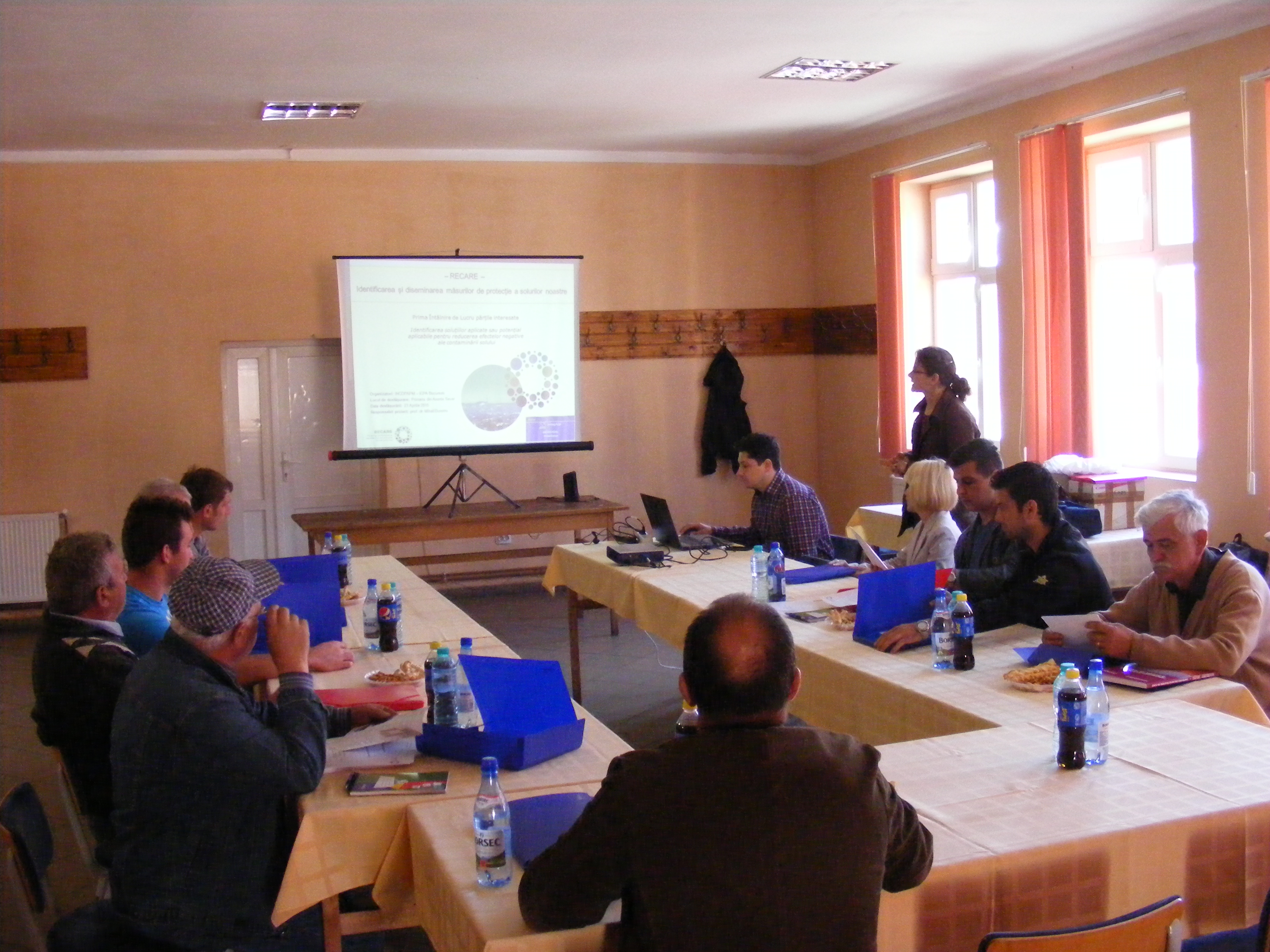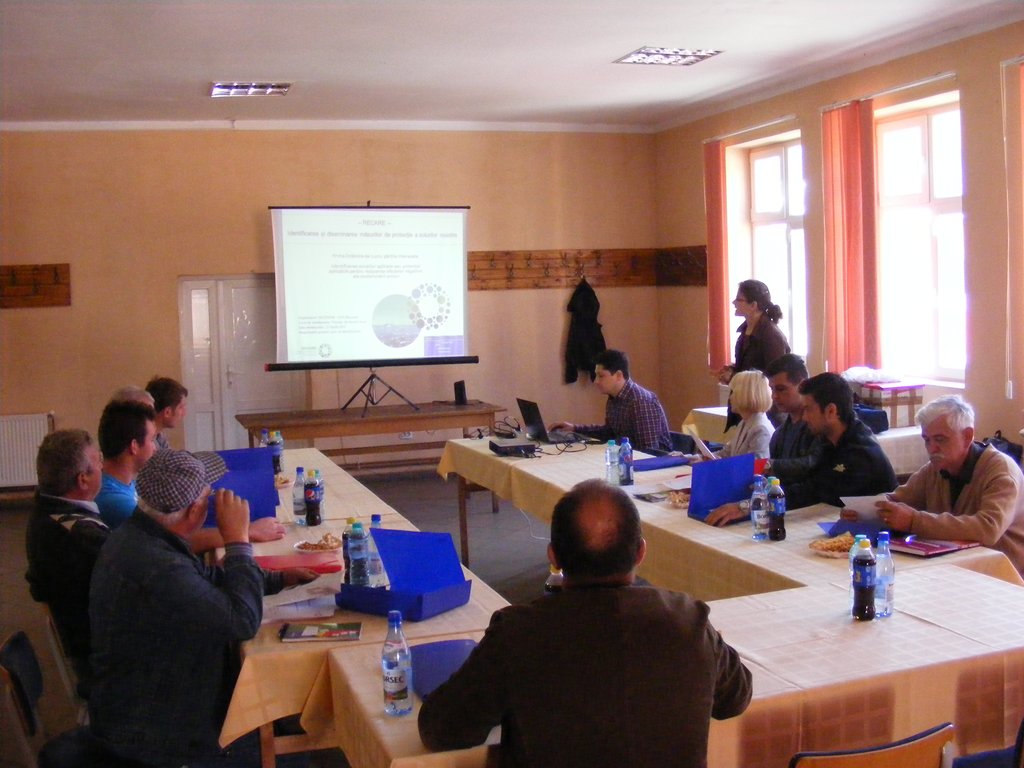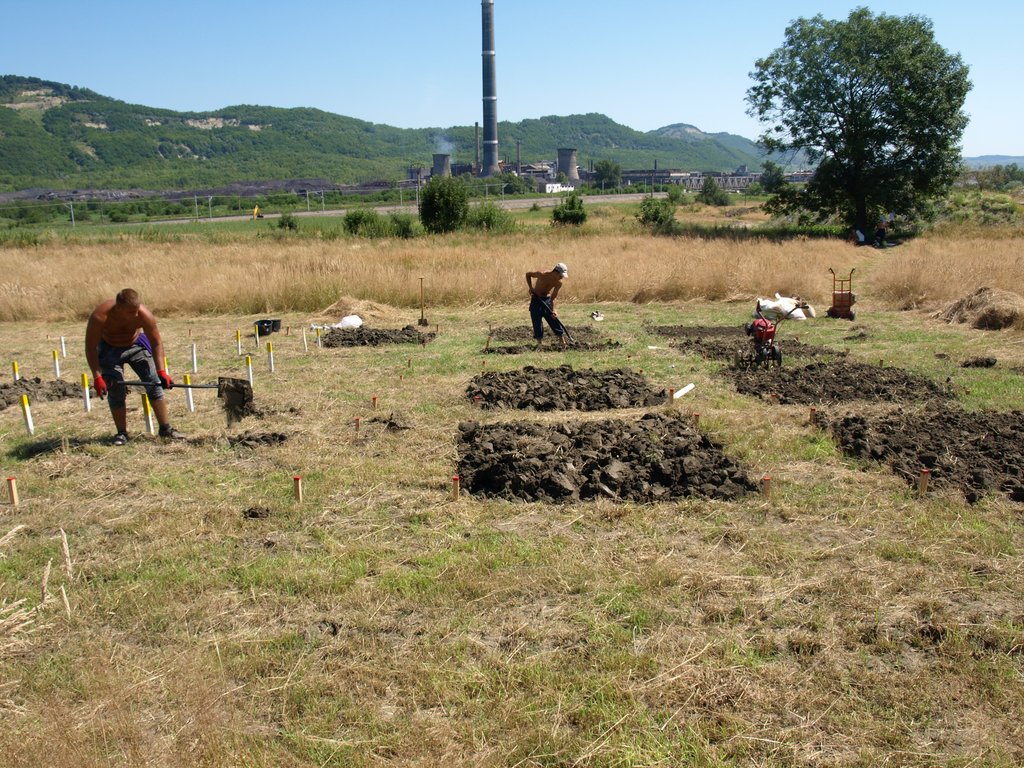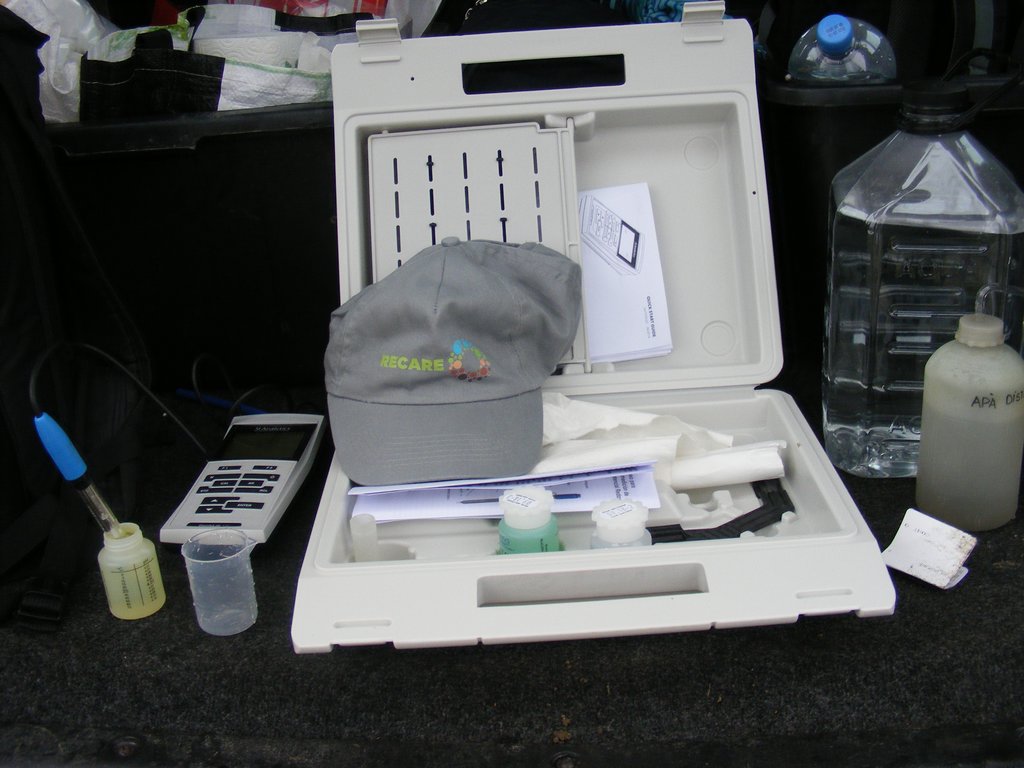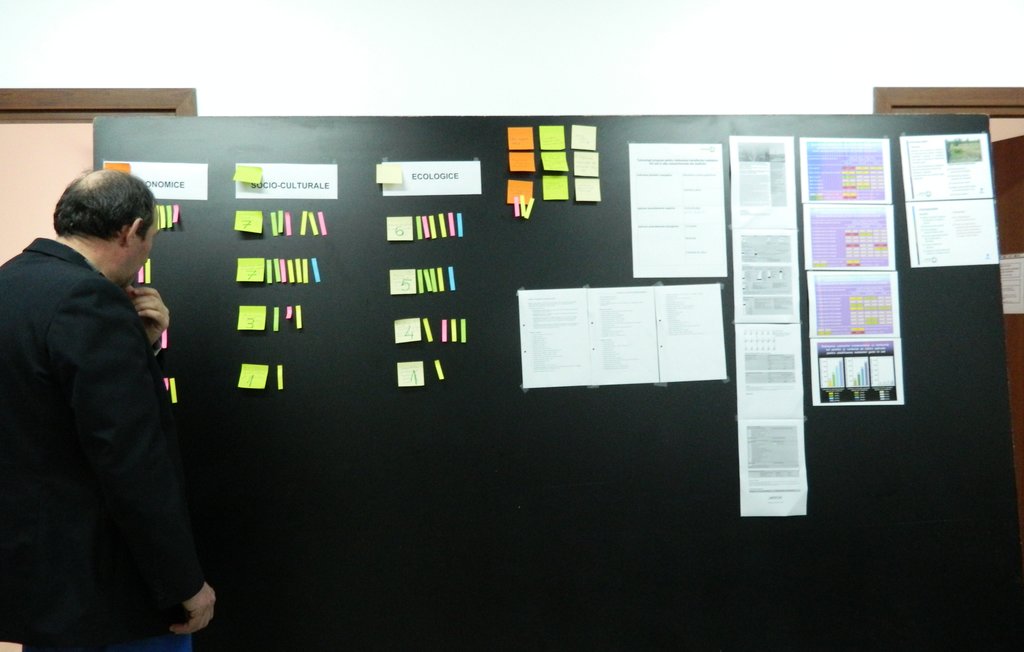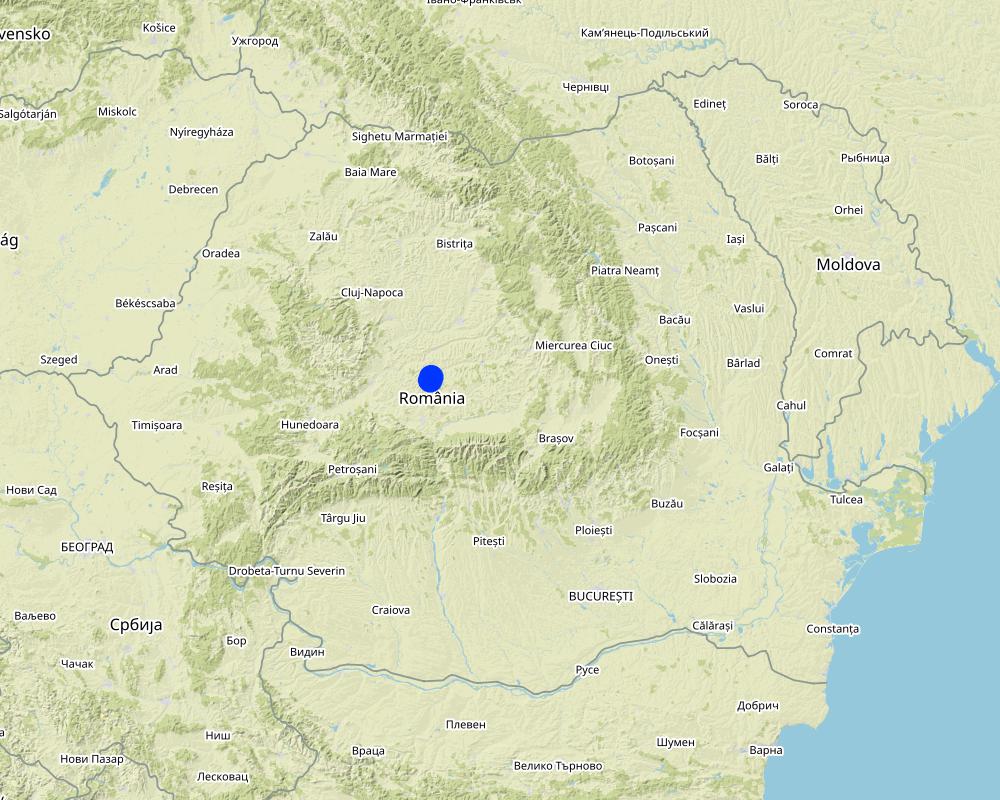Information and awareness raising for safe use of metal contaminated land [ໂລມາເນຍ]
- ການສ້າງ:
- ປັບປູງ:
- ຜູ້ສັງລວມຂໍ້ມູນ: Nicoleta Vrinceanu
- ບັນນາທິການ: –
- ຜູ້ທົບທວນຄືນ: GWJ van Lynden, Joana Eichenberger
Cresterea gradului de constientizare si informarea populatiei in scopul utilizarii in siguranta a terenurilor din zonele contaminate cu metale grele
approaches_570 - ໂລມາເນຍ
ເບິ່ງພາກສ່ວນ
ຂະຫຍາຍທັງໝົດ ຍຸບທັງໝົດ1. ຂໍ້ມູນທົ່ວໄປ
1.2 ລາຍລະອຽດ ການຕິດຕໍ່ ຂອງບຸກຄົນທີ່ຊັບພະຍາກອນ ແລະ ສະຖາບັນ ການມີສ່ວນຮ່ວມ ໃນການປະເມີນຜົນ ແລະ ເອກະສານ ຂອງວິທີທາງ
1.3 ເງື່ອນໄຂ ຂອງການນໍາໃຊ້ເອກກະສານຂໍ້ມູນ ຂອງ WOCAT
ເມື່ອໃດທີ່ໄດ້ສັງລວມຂໍ້ມູນ (ຢູ່ພາກສະໜາມ)?
02/03/2015
ຜູ້ສັງລວມ ແລະ ບັນດາຜູ້ຕອບແບບສອບຖາມ ຍອມຮັບໃນເງື່ອນໄຂ ການນໍາໃຊ້ຂໍ້ມູນເອກະສານ ທີ່ສ້າງຂື້ນ ໂດຍຜ່ານ ອົງການ WOCAT:
ແມ່ນ
2. ພັນລະນາ ແນວທາງການຄຸ້ມຄອງນໍາໃຊ້ດິນແບບຍືນຍົງ
2.1 ການອະທິບາຍ ໂດຍຫຍໍ້ ຂອງວິທີທາງ
The aim of this Aprroach is to increase the awareness about the risk related to agricultural use of contaminated land and to present the appropriate technologies for sustainable use of contaminated land in order to reduce the transfer of contaminants into the food chain. The implementation of appropriate SLM will improve the soil and crop quality with positive effects on the quality of life for local community from contaminated area.
2.2 ການອະທິບາຍ ລາຍລະອຽດ ຂອງວິທີທາງ
ການອະທິບາຍ ລາຍລະອຽດ ຂອງວິທີທາງ:
The Case Study area is located in Sibiu County, around the most important factory for processing of non-ferrous ores – Copsa Mica. The main environmental damages in the area Copşa Mică (Romania) are caused by ore processing and this town was classified as an environmental disaster area. The main pollutants identified in this area were cadmium, copper, lead and zinc. According to data from LPIS provided by Sibiu County Center of Agency for Payments and Intervention in Agriculture (2012) the arable land represents 60.4% from total area (2818.6ha) being located mainly in bottomland. Grassland represents 34.9% from total area, that means 1627.3 ha. Orchards and vineyards represent a very small proportion from total cultivated area, only 2.3% (106 ha) and 2.4% (110.3 ha).
Large scale migration from urban to rural areas (village surrounding the Copsa Mica) took place after reducing the activities of industrial platform. In villages located in polluted area there are many small landowners. The lands are used as agricultural land and the products are used for own consumption. Also, due to both, low fertility of soil (as a result of contamination) and lack of financial resources, there are lands abandoned. The agricultural use of the land represents a risk for population health and also reduces the number of methods that could be used for remediation.
The aim of the approach was to increase the awareness about the risk related to agricultural use of contaminated land and to present the appropriate technologies for sustainable use of contaminated land in order to reduce the transfer of contaminants into the food chain. The implementation of appropriate SLM will improve the soil and crop quality with positive effects on the quality of life for local community from contaminated area.
During workshops stakeholders are informed about state of soil degradation from their area, about risk related to agricultural use of contaminated land. The researchers and SLM experts share their experience with land owners and land users related to sustainable measures for reducing the effects of soil contamination and together they select the measures to be tested. The production of biomass for non-food purpose has been tested as a potential solution to produce valuable biomass while remediating the soil. Immobilization of heavy metals in soil was agreed by the traditional land owners who want to keep the agricultural use for their land.
Land owners offer the plot for testing the new technology and researchers / SLM experts organised experimental field and presenting the results to land owners, local authority, farmers, students during information session (field day, workshop)
2.3 ຮູບພາບຂອງແນວທາງ
ຂໍ້ສັງເກດໂດຍທົ່ວໄປກ່ຽວກັບການຮູບພາບ:
Activities for information and test the new technology selected by land users and experts
2.5 ປະເທດ / ເຂດ / ສະຖານທີ່ບ່ອນທີ່ແນວທາງໄດ້ຖືກນໍາໃຊ້
ປະເທດ:
ໂລມາເນຍ
ພາກພື້ນ / ລັດ / ແຂວງ:
Sibiu county
ຂໍ້ມູນເພີ່ມເຕີມຂອງສະຖານທີ່:
Copsa Mica
ຄວາມຄິດເຫັນ:
Both Copsa Mica and Axente Sever are located in highly contaminated area.
Map
×2.6 ວັນທີເລີ່ມຕົ້ນ ແລະ ສິ້ນສຸດ ການຈັດຕັ້ງປະຕີບັດ ວິທີທາງ
ຖ້າຫາກບໍ່ຮູ້ຈັກປີທີ່ແນ່ນອນ, ໃຫ້ປະມານຄາດຄະເນ ເອົາມື້ທີ່ໄດ້ເລີ່ມຈັດຕັ້ງປະຕິບັດ ວິທີທາງ:
ຕໍ່າກວ່າ 10 ປີ ຜ່ານມາ (ມາເຖິງປະຈຸບັນ)
2.7 ປະເພດຂອງແນວທາງ
- ພາຍໃຕ້ໂຄງການ / ແຜນງານ
2.8 ເປົ້າໝາຍ / ຈຸດປະສົງຫຼັກ ຂອງການຈັດຕັ້ງປະຕິບັດ ວິທີທາງ
The aim was to increase the awareness about the risk related to agricultural use of contaminated land and to present the appropriate technologies for sustainable use of contaminated land in order to reduce the transfer of contaminants into the food chain. The implementation of appropriate SLM will improve the soil and crop quality with positive effects on the quality of life for local community from contaminated area.
2.9 ເງື່ອນໄຂອໍານວຍ ຫຼື ຂັດຂວາງການປະຕິບັດຂອງເຕັກໂນໂລຢີ / ເຕັກໂນໂລຢີການນໍາໃຊ້ຕາມແນວທາງ
ສັງຄົມ / ວັດທະນະທໍາ / ມາດຕະຖານ ແລະ ຄຸນຄ່າທາງສາສະໜາ
- ເຊື່ອງຊ້ອນ
The traditional farmers want to preserve the agricultural use of land (crop production and grazing). Growing biofuel crops would require changing the land use for a long period of time.
ມີຄວາມສາມາດ / ເຂັ້າເຖິງຊັບພະຍາກອນດ້ານການເງິນ ແລະ ການບໍລິການ
- ເຊື່ອງຊ້ອນ
Lack of financial resources of the land users. The financial inputs for implementation are considered high even if there are subsidies for energy crops.
ການກໍ່ຕັ້ງສະຖາບັນ
- ເຊື່ອງຊ້ອນ
There are no interest for SLM on contaminated lands
ກ່ຽວກັບກົດໝາຍ (ສິດນໍາໃຊ້ດິນ, ສິດນໍາໃຊ້ນໍ້າ)
- ເຊື່ອງຊ້ອນ
Due to the large number of owners and the division of the land into small plots there are difficulties with respect to the application of appropriate SLM.
ນະໂຍບາຍ
- ເຊື່ອງຊ້ອນ
Although there are legal frameworks regarding pollution control there are no institutions responsible for the development and implementation of remediation measures. Also there are no clear legal descriptions of decision criteria for choosing the appropriate remediation actions.
ຄວາມຮູ້ກ່ຽວກັບການຄຸ້ມຄອງ ທີ່ດິນແບບຍືນຍົງ, ການເຂົ້າເຖິງການສະໜັບສະໜູນ ທາງດ້ານວິຊາການ
- ເຊື່ອງຊ້ອນ
Although there are known risks associated with soil contamination with heavy metals, landowners do not have enough information about SLM which could limit the transfer of metals into the food chain.
ຕະຫຼາດ (ໃນການຊື້ວັດຖຸດິບ, ຂາຍຜະລິດຕະພັນ) ແລະ ລາຄາ
- ເຊື່ອງຊ້ອນ
The energy crop market is not developed yet.
ວຽກ, ມີກໍາລັງຄົນ
- ອໍານວຍ
3. ການມີສ່ວນຮ່ວມ ແລະ ບົດບາດຂອງພາກສ່ວນທີ່ກ່ຽວຂ້ອງທີ່ໄດ້ມີສ່ວນຮ່ວມ
3.1 ຜູ້ມີສ່ວນຮ່ວມ ໃນວິທີທາງ ແລະ ພາລະບົດບາດ ຂອງເຂົາເຈົ້າ
- ຜູ້ນໍາໃຊ້ດິນໃນທ້ອງຖິ່ນ / ຊຸມຊົນທ້ອງຖິ່ນ
land users, local authority, farmers
They participate in information sessions and one land user offered a plot to test new technologies for immobilization of heavy metals in soil.
- ນັກຄົ້ນຄວ້າ
Researchers - soil scientist, enviromental experts,
They share their experience in respect with risk related with agricultural use of land in contaminated area and appropriate SLM for limiting the transfer of heavy metals into food chain.
3.2 ການມີສ່ວນຮ່ວມຂອງຜູ້ນໍາໃຊ້ທີ່ດິນໃນທ້ອງຖິ່ນ / ຊຸມຊົນທ້ອງຖິ່ນໃນໄລຍະທີ່ແຕກຕ່າງກັນຂອງແນວທາງ
| ການລວບລວມ ເອົາຜູ້ນໍາໃຊ້ດິນ ໃນທ້ອງຖິ່ນ / ຊຸມຊົນທ້ອງຖິ່ນ | ໃຫ້ລະບຸ ຜູ້ໃດທີ່ມີສ່ວນຮ່ວມ ໃນແຕ່ລະກິດຈະກໍາ? | |
|---|---|---|
| ການເລີ່ມຕົ້ນ / ແຮງຈູງໃຈ | ການບໍ່ປະຕິບັດ | Researchers organised information sessions (workshops and stakeholder meetings) for land owners, local authority, farmers, students. |
| ການວາງແຜນ | ການຮ່ວມມື | Researchers and SLM experts organised participatory sessions with land owners, local authority, farmers, students in order to select the appropriate SLM Technology to be tested. |
| ການປະຕິບັດ | ການຮ່ວມມື | Land owners offer the plot for testing the new technology and researchers and SLM experts organised experimental field and presenting the results to land owners, local authority, farmers, students during information session (field day, workshop) |
| ຕິດຕາມກວດກາ / ການປະເມີນຜົນ | ບໍ່ມີ | |
| Research | ບໍ່ມີ |
3.3 ແຜນວາດ (ຖ້າມີ)
ການອະທິບາຍ:
NA
3.4 ການຕັດສິນໃຈກ່ຽວກັບການຄັດເລືອກເຕັກໂນໂລຢີຂອງການຄຸ້ມຄອງທີ່ດິນແບບຍືນຍົງ / ເຕັກໂນໂລຢີ
ລະບຸ ຄົນທີ່ຕັດສິນໃຈ ກ່ຽວກັບການຄັດເລືອກຂອງ ເຕັກໂນໂລຢີ / ເຕັກໂນໂລຢີ ຈະໄດ້ຮັບການປະຕິບັດ:
- ຜູ້ນໍາໃຊ້ທີ່ດິນຫຼັກ, ການສະໜັບສະໜູນ ໂດຍຜູ້ຊ່ຽວຊານ ການນໍາໃຊ້ທີ່ດິນແບບຍືນຍົງ
ອະທິບາຍ:
Selection of appropriate SLM Technologies was made by land users, farmers and land owners suppoted by SLM specialists during participatory sessions.
Specify on what basis decisions were made:
- ປະເມີນເອກກະສານ ຄວາມຮູ້ກ່ຽວກັບ ການຄຸ້ມຄອງ ທີ່ດິນແບບຍືນຍົງ (ຫຼັກຖານທີ່ຊ່ວຍໃນການຕັດສິນໃຈ)
- ຜົນທີ່ໄດ້ຮັບ ຈາກການຄົ້ນຄວ້າ
- ປະສົບການສ່ວນບຸກຄົນ ແລະ ຄວາມຄິດເຫັນ (ທີ່ບໍ່ເປັນເອກກະສານ)
4. ການສະໜັບສະໜູນທາງດ້ານວິຊາການ, ການສ້າງຄວາມສາມາດ, ແລະ ການຈັດການຄວາມຮູ້.
4.1 ການສ້າງຄວາມສາມາດ / ການຝຶກອົບຮົມ
ຜູ້ນໍາໃຊ້ທີ່ດິນ ຫຼື ພາກສ່ວນກ່ຽວຂ້ອງອື່ນໆ ໄດ້ຮັບການຝຶກອົບຮົມບໍ່?
ແມ່ນ
ໃຫ້ລະບຸ ຜູ້ໃດທີ່ໄດ້ຮັບການຝຶກອົບຮົມ:
- ຜູ້ນໍາໃຊ້ດິນ
ຮູບແບບຂອງການຝຶກອົບຮົມ:
- ຕົວຕໍ່ຕົວ
- ເນື້ອທີ່ສວນທົດລອງ
- ກອງປະຊຸມ
ໃນຫົວຂໍ້:
Status of soil degradation by heavy metal contamination. Risk related to agricultural use of contaminated land. Measures for reducing the transfer of contaminants into food chain.
4.2 ການບໍລິການໃຫ້ຄໍາປຶກສາ
ເຮັດຜູ້ໃຊ້ທີ່ດິນມີການເຂົ້າເຖິງການບໍລິການໃຫ້ຄໍາປຶກສາ?
ແມ່ນ
ລະບຸວ່າການສະໜອງ ການບໍລິການ ໃຫ້ຄໍາປຶກສາ:
- ໃນພື້ນທີ່ຂອງຜູ້ນໍາໃຊ້ດິນ
4.3 ສະຖາບັນການສ້າງຄວາມເຂັ້ມແຂງ (ການພັດທະນາອົງການຈັດຕັ້ງ)
ສະຖາບັນ ໄດ້ຮັບການສ້າງຕັ້ງຂື້ນ ຫຼື ໄດ້ຮັບການສ້າງຄວາມເຂັ້ມແຂງ ໂດຍການຈັດຕັ້ງປະຕິບັດ ວິທີທາງບໍ່?
- ບໍ່ມີ
4.4 ຕິດຕາມກວດກາ ແລະ ປະເມີນຜົນ
ການຈັດຕັ້ງປະຕິບັດ ວິທີທາງ ໄດ້ມີການປະເມີນຜົນ ແລະ ຕິດຕາມບໍ?
ແມ່ນ
ຖ້າແມ່ນ, ເອກກະສານສະບັບນີ້ ແມ່ນໄດ້ນໍາໃຊ້ເຂົ້າໃນການຕິດຕາມ ແລະ ປະເມີນຜົນບໍ່?
ແມ່ນ
4.5 ການຄົ້ນຄວ້າ
ນີ້້ແມ່ນສ່ວນໜຶ່ງ ການຄົ້ນຄວ້າ ຂອງວິທີທາງບໍ່?
ແມ່ນ
ລະບຸ ຫົວຂໍ້:
- ລະບົບນິເວດ
5. ການສະໜັບສະໜູນທາງດ້ານການເງິນ ແລະ ອຸປະກອນຈາກພາຍນອກ
5.1 ງົບປະມານປະຈໍາປີ ສໍາລັບວິທີທາງ ຂອງການຄຸ້ມຄອງ ທີ່ດິນແບບຍືນຍົງ
ຖ້າຫາກບໍ່ຮູ້ຈັດງົບປະມານທີ່ແນ່ນອນ ແມ່ນໃຫ້ປະມານເອົາ:
- 2,000-10,000
ຄໍາເຫັນ (ຕົວຢ່າງ: ແຫຼ່ງຂໍ້ມູນຫຼັກ ຂອງການສະໜອງທຶນ / ຜູ້ໃຫ້ທຶນທີ່ສໍາຄັນ):
Research projects funding from National Research Fund and EU projects
5.2 ການສະໜັບສະໜູນ ທາງດ້ານການເງິນ / ອຸປະກອນ ສະໜອງໃຫ້ແກ່ຜູ້ນໍາທີ່ດິນ
ຜູ້ນໍາໃຊ້ດິນ ໄດ້ຮັບການສະໜັບສະໜູນ ທາງດ້ານ ການເງິນ / ອຸປະກອນ ໃນການຈັດຕັ້ງປະຕິບັດ ເຕັກໂນໂລຢີບໍ?
ແມ່ນ
ຖ້າແມ່ນ, ໃຫ້ລະບຸປະເພດ (ຫຼາຍ) ຂອງການສະໜັບສະໜູນ, ເງື່ອນໄຂ ແລະ ຜູູ້ສະໜອງ (ຫຼາຍ):
Subsidies for energy crops
5.3 ເງິນສົມທົບສໍາລັບການນໍາໃຊ້ສະເພາະປັດໃຈຂາເຂົ້າໃນການຜະລີດກະສິກໍາ (ລວມທັງແຮງງານ)
- ກະສິກໍາ
| ໃຫ້ລະບຸໄດ້ຮັບການສະໜັບສະໜູນປັດໃຈຂາເຂົ້າຫຍັງແດ່ | ທີ່ຂອບເຂດ | ລະບຸ ການອຸດໜູນ |
|---|---|---|
| ແນວພັນ, ແກ່ນພັນ | ງົບປະມານບາງສ່ວນ | 173 US$ / ha - spring 2015 |
5.4 ສິນເຊື່ອ
ໄດ້ປ່ອຍສິນເຊື່ອ ສະໜອງໃຫ້ພາຍໃຕ້ ວິທີການສໍາລັບກິດຈະກໍາ ການຄຸ້ມຄອງ ທີ່ດິນແບບຍືນນຍົງບໍ່?
ບໍ່ແມ່ນ
5.5 ສິ່ງຈູງໃຈ ຫຼື ເຄື່ອງມືອື່ນໆ
ການສົ່ງເສີມ ຈັດຕັ້ງປະຕິບັດ ເຕັກໂນໂລຢີ ໃນການຄຸ້ມຄອງ ດິນແບບຍືນຍົງ ໄດ້ສະໜອງສິ່ງກະຕຸກຊຸກຍູ້ບໍ່?
ບໍ່ແມ່ນ
6. ວິເຄາະຜົນກະທົບ ແລະ ສັງລວມບັນຫາ
6.1 ຜົນກະທົບຂອງແນວທາງ
ການນໍາໃຊ້ ວິທີທາງ ສາມາດປັບປຸງຄວາມຮູ້ ແລະ ຄວາມສາມາດຂອງຜູ້ນໍາໃຊ້ທີ່ດິນ ໃນການປະຕິບັດ ການຄຸ້ມຄອງ ທີ່ດິນແບບຍືດຍົງໄດ້ບໍ່?
- ບໍ່
- ມີ, ໜ້ອຍໜຶ່ງ
- ມີ, ພໍສົມຄວນ
- ມີ, ຫຼາຍ
Were highlighted risks of agricultural use of contaminated land and the possibilities of limiting the transfer of contaminants into the food chain by changing land use or by immobilizing metals in soil.
ການນໍາໃຊ້ ວິທີທາງ ໄດ້ປັບປຸງ ການຈ້າງງານ, ໂອກາດ ໃນການສ້າງລາຍຮັບບໍ່?
- ບໍ່
- ມີ, ໜ້ອຍໜຶ່ງ
- ມີ, ພໍສົມຄວນ
- ມີ, ຫຼາຍ
Implementing the SLM could lead to high economic value of the crop (biomass fuel production, healthy crops, etc).
6.2 ແຮງຈູງໃຈຫຼັກຂອງຜູ້ນໍາໃຊ້ທີ່ດິນໃນການປະຕິບັດການຄຸ້ມຄອງທີ່ດິນແບບຍືນຍົງ
- ການຜະລິດເພີ່ມຂຶ້ນ
- ກໍາໄລເພີ່ມຂຶ້ນ (ຄວາມສາມາດ), ການປັບປຸງຄ່າໃຊ້ຈ່າຍ, ຜົນປະໂຫຍດ, ອັດຕາສ່ວນ
- ການຊໍາລະເງິນ / ເງິນອຸດໜູນ
The farmers recieved the subsidiy for energy crops.
6.3 ຄວາມຍືນຍົງຂອງກິດຈະກໍາວິທີທາງ
ຜູ້ນໍາໃຊ້ ທີ່ດິນ ສາມາດສືບຕໍ່ ການຈັດຕັ້ງປະຕິບັດ ຜ່ານວິທີທາງໄດ້ບໍ່ (ໂດຍປາດສະຈາກ ການຊ່ວຍເຫຼືອ ຈາກພາກສ່ວນພາຍນອກ)?
- ບໍ່ມີ
ຖ້າ ບໍ່ ຫຼື ບໍ່ແນ່ໃຈ, ໃຫ້ອະທິບາຍ ແລະ ຄໍາເຫັນ:
They need financial support to continue application of selected SLM.
6.4 ຈຸດແຂງ / ຂໍ້ດີ ຂອງວິທີທາງ
| ຈຸດແຂງ / ຂໍ້ດີ / ໂອກາດໃນການນໍາໃຊ້ທີ່ດິນ |
|---|
| Receiving the knowledge tools to improve the quality of crops and offering the possibility to provide new products (from biofuel crops) on the market which increase the farm income. |
| ຈຸດແຂງ / ຈຸດດີ / ໂອກາດ ຈາກທັດສະນະຂອງຜູ້ປ້ອນຂໍ້ມູນ ຫຼື ບຸກຄົນສຳຄັນ |
|---|
| Awareness raising about the risk related to agricultural use of contaminated land lead to increase the number of land users which want to implement appropriate SLM for contaminated land. |
6.5 ຈຸດອ່ອນ / ຂໍ້ເສຍຂອງແນວທາງ ແລະ ວິທີການແກ້ໄຂໃຫ້ເຂົາເຈົ້າ
| ຈຸດອ່ອນ / ຂໍ້ເສຍ / ຄວາມສ່ຽງໃນມູມມອງຂອງຜູ້ນໍາໃຊ້ທີ່ດິນ | ມີວິທີການແກ້ໄຂຄືແນວໃດ? |
|---|---|
|
Difficulties to continue the activities initiated without external financial input. |
Subsidies |
| Undeveloped energy crop market | Support for creating local or regional markets for energy crops |
| ຈຸດອ່ອນ ຫຼື ຂໍ້ເສຍ ຫຼື ຄວາມສ່ຽງ ໃນມຸມມອງຂອງ ຜູ້ສັງລວມຂໍ້ມູນ ຫຼື ບັນດາຜູ້ຕອບແບບສອບຖາມ | ມີວິທີການແກ້ໄຂຄືແນວໃດ? |
|---|---|
| Inadequate authorities' interest for SLM | The authorities have to provide help in order to meet the needs (support for poor land users) in order to implement SLM activities to change land uses or to adopt measures for reducing transfer of contaminants into the food chain. |
7. ເອກກະສານອ້າງອີງ ແລະ ຂໍ້ມູນການເຊື່ອມໂຍງ
7.1 ວິທີການ / ແຫຼ່ງຂໍ້ມູນ
- ການໄປຢ້ຽມຢາມພາກສະໜາມ, ການສໍາຫຼວດພາກສະໜາມ
- ການສໍາພາດ ຜູ້ນໍາໃຊ້ທີ່ດິນ
- ການລວບລວມ ບົດລາຍງານ ແລະ ເອກະສານອື່ນໆ ທີ່ມີຢູ່ແລ້ວ
7.2 ເອກະສານທົ່ວໄປທີ່ສາມາດໃຊ້ໄດ້
ຫົວຂໍ້, ຜູ້ຂຽນ, ປີ, ISBN:
Nicoleta Vrinceanu, Motelica, D.M., Dumitru, M., Eugenia GAMENŢ, Calciu, I., Veronica Tanase, Mihaela Preda (2008) – Assessment of Some Inorganic Additives Used for In-Situ Remediation of Heavy Metals Polluted Soils, Abstract book of The 1st European Conference on Remediation of Soil, sediment and Groundwater – Biological, Chemical and Physical Technologies, 21–23 october 2008, Amsterdam, Olanda, p.173.
ຫົວຂໍ້, ຜູ້ຂຽນ, ປີ, ISBN:
Comănescu, l., Nedelea, A., Paisa, M., 2010. Soil pollution with heavy metals in the area of Copșa Mică town – Geographical considerations, Metalurgia International XV 4, 81-85.
ຫົວຂໍ້, ຜູ້ຂຽນ, ປີ, ISBN:
Lăcătușu, R., Lăcătușu, A.R., 2010. Evolution of heavy metals pollution from Copșa Mică. Scientific Papers, UASVM Bucharest, Series A, LIII, 85-92.
ຫົວຂໍ້, ຜູ້ຂຽນ, ປີ, ISBN:
Petronela-Bianca Pavel, Puschenreiter, M., Wenzel, W.W., Elena Diacu, Barbu, C.H., Aided phytostabilization using Miscanthus sinensis × giganteus on heavy metal-contaminated soils, Science of the Total Environment 479–480 (2014) 125–131
7.3 ການເຊື່ອມຕໍ່ກັບຂໍ້ມູນທີ່ກ່ຽວຂ້ອງທີ່ສາມາດໃຊ້ອອນໄລນ໌
ຫົວຂໍ້ / ພັນລະນາ:
Miscanthus giganteus - o solution for contaminated land
URL:
http://www.tribuna.ro/stiri/actualitate/miscanthus-plantat-la-cop-sa-mic-a-inc-a-din-2007-51036.html
ຫົວຂໍ້ / ພັນລະນາ:
Miscanthus giganteus - the crops too expensive for romanian farmers
URL:
http://www.tribuna.ro/stiri/eveniment/culturile-de-miscanthus-prea-scumpe-pentru-agricultorii-sibieni-76070.html
ຫົວຂໍ້ / ພັນລະນາ:
*** Annual Report of EPA Sibiu County. 2012. (in Romanian)
URL:
http://apmsb.anpm.ro/upload/62681_Raport%20anual%20privind%20monitorizarea%20PIGCA%20pentru%20anul%202011.pdf
ຂໍ້ມູນການເຊື່ອມຕໍ່ ແລະ ເນື້ອໃນ
ຂະຫຍາຍທັງໝົດ ຍຸບທັງໝົດການເຊື່ອມຕໍ່
ບໍ່ມີຂໍ້ມູນການເຊື່ອມຕໍ່
ເນື້ອໃນ
ບໍ່ມີເນື້ອໃນ


